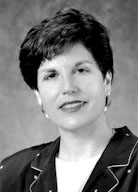|
January 19, 2004
Workshop outlines fundraising challenge posed
by demographic changes
By Louise Donahue
Talk of “boomers,” “busters,” “civics,”
and a new species, “boomlets,” was everywhere on January 13
during a daylong workshop with fundraiser Judith Nichols for faculty
and staff on how to increase individual donations to UCSC.
|

|
| Judith Nichols said different
generations vary widely in their communication preferences. |
Nichols, who has worked with educational and nonprofit groups around
the United States and the United Kingdom, drove home the point that
demography is a subject fundraisers ignore at their peril.
“Around the mid-1990s, a lot of what we were doing in fundraising
stopped working so well, but we continued doing it,” she said at
the workshop, held at the Colleges Nine and Ten Multipurpose Room and
the Alumni Association Room at the University Center.
“We need to understand what’s driving the outer world and
bring it into ours.”
UCSC initiatives to increase individual donations were outlined briefly
by Vice Chancellor of University Relations Ron Suduiko. “Building
an individual donor base drives us, and it, and alumni support, are
growing,” he said. In the U.S. News and World Report rankings,
UCSC compares favorably with its counterparts within the UC system as
well as with other leading public research institutions.
Five online alumni newsletters, representing one department in each
division, are being sent out this winter to help alumni keep in touch
with UCSC, explained Lynn Zachreson, on-campus programs coordinator
for the Alumni Office. There are online alumni newsletters for literature,
chemistry,
psychology,
film
and digital media, and computer
science, with more planned.
While many nonprofit groups have long relied on the generation that
came of age before or during World War II, new approaches are needed,
Nichols said, as the older generation is gradually supplanted. Greater
longevity is also creating major changes, as potential donors worry
about outliving their assets. “When paradigms shift, there are
both risks and opportunities. It’s time to make the changes now,
before we find ourselves in crisis,” Nichols emphasized.
One crucial difference in the generations is in their style of communications.
The World War II generation, called the “civics” for their
involvement in community and country, prefers direct-mail appeals, but
may not want face-to-face contact. Those in their 30s to mid-50s would
like face-to-face contact, but can be successfully reached with approaches
that mimic face-to-face contact, such as phone calls or videos. The
youngest group, under age 35, is best reached through the Internet and
college radio.
Different age groups also vary in what drives their giving. While older
givers prefer an organization with a long track record, younger audiences
want to know explicitly how their gift will benefit society. This has
been a secondary message for universities, but it now has to be a primary
message, Nichols said.
While exact dates vary, she said, baby boomers are considered to be
those born between 1943 and 1960; “baby busters,” also called
Generation X, were born between 1961 and 1981; and the “baby boomlet,”
also sometimes called “generation next,” “generation
Y,” or “generation net,” were born between 1982 and 1992.
The starkest example of targeting to a specific audience came as Nichols
showed the gathering a short video about the work of the Salvation Army.
Aimed at civic-minded entrepreneurs, the video included vivid comments
from people served by Salvation Army programs for children and adults,
and ended with heart-wrenching accounts from women in a Salvation Army
battered women’s shelter. The campaign was extremely successful
with its target audience, Nichols said, but when the video was shown
to an older group of “civics”—an age group that has strongly
supported the Salvation Army over the years—it drew a negative
reaction, and some people even walked out.
No matter what the age of the donor, Nichols emphasized the importance
of every donation, offering her own experience with the United Nations
Children’s Fund, or UNICEF, as an example. The response she received
after making a $25 gift one year gradually led to more and larger donations,
and now she has included UNICEF in her will.
Nichols touched on a number of other issues during the workshop, including:
Diversity: Those seeking to raise funds for universities will
need to improve their understanding of cultural differences. Noting
that African Americans are the most philanthropic ethnic group in the
nation, Nichols said it is important that development staffs be diverse.
“We have some work to do there,” she said.
Starting early: Nichols emphasized the importance of reaching
donors earlier, in their 20s and 30s, to establish a relationship that
can grow over time, reminding the audience that few people start giving
to a new charity in their 90s.
Impact of longevity: While fundraisers have assumed in the past
that people will give away money before they die, longer life expectancies
mean people are now increasingly worried about outliving their assets.
This may lead some fundraisers to incorporate an estate planning element
in their approach to potential donors.
Faculty who have questions or want to know more about alumni fundraising
and outreach are welcome to contact their divisional development officers
or Paul Prokop, associate vice
chancellor for development.
Return to Front Page
|